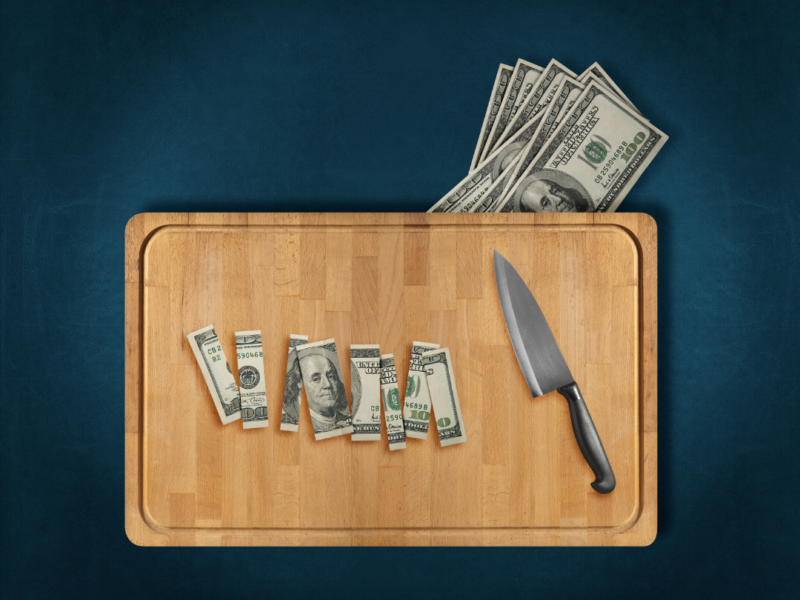How to reduce bank fees: Learn how to lower banking fees with these 7 tips. You might even get rid of costly bank fees altogether. This article may contain affiliate links.
When I was 12 years old, my parents took me to the local bank to open my first bank account. What an exciting time! I finally had a place to keep my hard-earned money.
Of course, at that time, I had no idea that banks are in no way charitable institutions. Having a youth bank account is free, but as an adult, banking can be expensive.
If you are a frequent reader of Reverse the Crush, you know that I live a lean lifestyle by reducing my expenses as much as possible. However, I still live a balanced life and don’t deprive myself at all.
In this post, I will show you how to reduce bank fees with 7 tips. Potentially, you might even, dare I say, eliminate bank fees altogether.
Let’s get started.
How To Reduce Bank Fees: 7 Foolproof Ways To Save Your Hard-Earned Money

1. Take Advantage of a Credit Card
Using a credit card for your day-to-day expenses is a great way to avoid pesky transaction fees. After all, credit cards do not have monthly transaction fees, so you can make unlimited transactions without a worry.
It should go without saying, though, that you must absolutely pay off your balance each month before the due date to avoid interest charges.
If you know how to use your credit card wisely, not only will you avoid transaction fees, but you also earn rewards, depending on the type of card you hold.
There are several ways to take advantage of a credit card to reduce bank fees:
Pre-pay your credit card
If you are the type of person who can easily lose track of your credit card expenses, it may be a good idea to prepay your credit card from your chequing account. By doing so, it will be easier to keep track of and stay within your budget. For example, let’s say you budget $500/month to pay for expenses such as groceries, transportation, subscriptions, and cellphone bill. On your pay day, transfer $500 to your credit card (even if your current credit card balance is zero), and use your card from then on to pay for said expenses.
Pre-authorize bills using your credit card
The title is self-explanatory: for whatever automatic bills you have each month, check with the service provider if they allow the payment to be taken from a credit card. In Canada, pretty much most service providers (cable, cell phone, insurance, etc) allow payments to be automatically taken from a credit card.
Use your credit card as a debit card
I would recommend this method only if you have extreme self-control when it comes to spending. Use your credit card as if you would your debit card, and ensure to pay the full statement balance each month to avoid interest.
2. Utilize Virtual Banks
Back in the day, banking was an errand that required you to go to a branch in person to pay bills, transfer money, and complete simple activities that are now done with the click of a button.
I can’t say this enough (I am biased), but the Internet is really a wonderful thing.
With the advance of virtual banks, we have more options than ever when it comes to banking. Because virtual banks do not incur the costs of brick-and-mortar establishments (such as rent payments for physical locations and additional staffing expenses), they can afford to offer no-fee banking options.
If you are comfortable with self-managing your banking and require minimal assistance, check out the options below to reduce bank fees. Virtual banks offer 24/7 customer service, in addition to chat and e-mail options.
Simplii Financial
Questrade (for investments)
3. Be on Top of your Payments
To make life easier, pretty much every company out there offers the option to pre-authorize payments, so that they are automatically debited from your account on an agreed upon date.
But of course, that comes with a cost, if you’re not on top of your account balance and due dates. If a pre-authorized payment does not go through due to non-sufficient funds, your bank will charge you an NSF fee, which can vary from $45 to $48 (based on the top 5 banks in Canada).
On top of that, the company you set up the pre-authorized payment with will likely also charge you an insufficient funds fee.
To avoid these extra costs, you need to make sure you know when each payment will be debited. Make a chart if you need to, and make sure your account has enough funds one business day before the scheduled payment date.
Most banks even offer alerts that will notify you before a payment is due as a reminder to deposit funds.
In some circumstances, as a last resort, you can choose to add a stop payment, which typically cost between $12.50 and $25.00 – half of what an NSF would cost.
Tip: EQ Bank does not charge clients NSF fees. If you sign up using my link…
4. Take Advantage of Offers
For the record, I am not an advocate for wasting time on applying for accounts and credit cards just to get the sign-up reward they offer.
Nonetheless, it does make sense to ask your bank if you qualify for any offers within your existing accounts.
If you’re a student for example, you can get free banking, as long as you show proof that you are enrolled in school.
Similarly, seniors get special benefits if they meet a certain age threshold.
5. Look for Fee Waiver Options
Similar to taking advantage of account offers, it’s worth it to look into fee waiver options offered for your account type. If the account you hold does not offer such feature, it may make sense to switch to an account type that does.
Having a fee waiver means your monthly fee will be reimbursed as long as you meet certain requirements – which varies from bank to bank.
Some banks will reimburse your monthly fee if you keep a certain balance in your chequing account. Let’s take CIBC, for example: by keeping $4,000 on their Smart Checking Account, you avoid the monthly fee, which can be as high as $16.95 if you make more than 12 debit transactions in a month.
If you’re not investing that $4,000, would you ever earn $16.95 in interest in a regular savings account?
6. Use your Bank’s ATMs Only
Although cash is practically useless, you may need to withdraw some every now and then.
When the time comes, please do yourself a favour and use your own bank’s ATM. Not sure if there is one nearby? We all have smartphones, simply open your bank’s app and use their locator. Chances are they will have an ATM nearby.
When you use another bank’s ATM, you get charged two fees: one from your bank and one from the bank that owns the ATM you used.
If there are no ATMs nearby, another option is to request cash back from a merchant. Most grocery stores and other merchants offer this option nowadays.
7. Avoid Paper Fees
Again, the Internet is a beautiful thing.
Most banks will charge you a fee for paper statements and other documents, if they are mailed to you on a regular basis.
By switching to electronic options, you can cut these costs to zero. As an added bonus, you are also being environmentally friendly.
In this day and age, there is really no need for you to keep stashes of documents in a drawer that never gets opened. Save money and declutter by keeping digital copies. If for any reason you need a paper copy, you can always request one through your bank or print it off online.

How to Reduce Bank Fees – Final Thoughts
Life if expensive enough. There are always ways to cut down expenses and use savings to help grow your money.
Whether it’s taking advantage of a credit card, utilizing virtual banks, or eliminating paper costs, I hope these 7 tips help you reduce bank fees or even eliminate them completely.
Do you use any of the tips in this post to reduce your bank fees? Are there any other ways to cut banking costs?
I would love to hear your thoughts in the comments below.
Related Personal Finance Articles To Check Out
Save Money Around The House: 7 Eco-Friendly Ways To Spend Less
I am not a licensed investment or tax adviser. All opinions are my own. This post may contain advertisements by Monumetric. This post may also contain internal links, affiliate links to BizBudding, Amazon, Bluehost, and Questrade, links to trusted external sites, and links to RTC social media accounts.
Connect with RTC
Twitter: @Reversethecrush
Pinterest: @reversethecrushblog
Instagram: @reversethecrush_
Facebook: @reversethecrushblog
Email: graham@reversethecrush.com


 Hobbies To Make Money: 12 Truly Enjoyable Hobbies That Pay (2021)
Hobbies To Make Money: 12 Truly Enjoyable Hobbies That Pay (2021)
